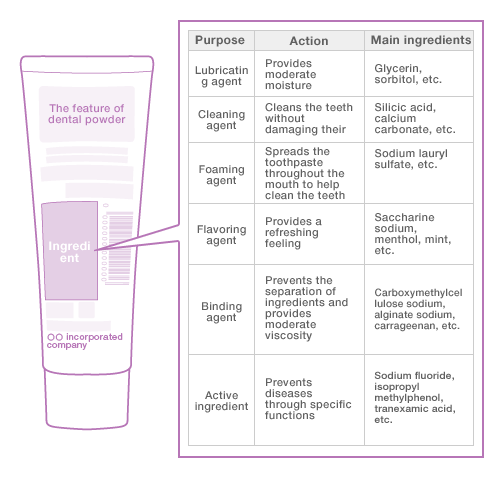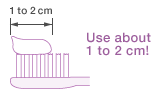how to choose toothpaste ??
Toothpaste contains ingredients suitable for each purpose, such as the prevention of caries, periodontal disease or tartar. Get to know the effects of each ingredient and choose toothpaste that suits the conditions of your mouth.

- Get to know the features of toothpaste, and choose a product that suits the conditions of your mouth or your purposes.
Toothpaste Ingredients
Toothpaste contains ingredients suitable for each purpose.
Major active ingredients and their effects
Toothpaste tubes or the packaging contain a label listing the ingredients of the product. In addition, if toothpaste has a label of “quasi drug”, this indicates that the product contains active ingredients.
 Major Ingredients and Their Effects
Major Ingredients and Their EffectsStandard Usage Amount
 Standard Usage Amount
Standard Usage Amount
Use about 1 to 2 cm (approx. 1g) of toothpaste each time, so that the active ingredients can maximally exert their effects.

- “Won’t abrasives contained in toothpaste damage the surface of my teeth?”Toothpaste contains abrasives that have been confirmed not to be damaging to teeth. If brushing is performed correctly, it will not damage your teeth.
points to note when Choosing Toothpaste
By choosing and using toothpaste with medicinal effects that suit your purposes, it will be more effective in protecting your teeth and mouth.
| Active ingredient | Major Action/mechanism | Actions |
| Sodium monofluorophosphate (fluorine) | Strengthens the tooth substrate, promotes remineralization, suppresses acid production | Prevents caries and progression of caries |
| Sodium fluoride (fluorine) | ||
| Tranexamic acid | Anti-inflammatory effect | Prevents gingivitis and periodontitis (pyorrhea) Prevents bleeding |
| Phellodendron amurense extract | Anti-inflammatory effect, astringent effect | Prevents gingivitis and periodontitis (pyorrhea) |
| Dipotassium glycyrrhizate | Anti-inflammatory effect | Prevents gingivitis and periodontitis (pyorrhea) Prevents bad breath |
| β-Glycyrrhetinic acid | ||
| Tocopherol acetate (vitamin E) | Promotion of Blood circulation | |
| Sodium chloride | Astringent effect | |
| Isopropyl methylphenol (IPMP) | Disinfecting effect | Prevents gingivitis Prevents bad breath Prevents caries and progression of caries |
| Cetylpyridinium chloride (CPC) | ||
| Sodium lauroyl sarcosinate (LSS) | Prevents bad breath Prevents caries and progression of caries | |
| Aluminum lactate | Occlusion of dentinal tubules | Prevents teeth sensitivity |
| Potassium nitrate | Prevents transmission of stimulus | |
| Polyethyleneglycol | Breaks down cigarette tar and nicotine | Removes cigarette tar and nicotine |
| Polyphosphate sodium | Prevents tartar formation, separates cigarette stains from the teeth | Prevents tartar deposition Removes cigarette tar and nicotine |

- “Children should only use toothpaste after they learn to rinse their mouth.”Most toothpaste for children contains fluorine and is effective for strengthening their teeth. Small children, however, have the tendency to dislike brushing their teeth, and there is a concern that they may swallow toothpaste since they cannot rinse their mouths thoroughly. Since toothpaste should basically be rinsed out of the mouth, children should use it only after they learn to rinse their mouths thoroughly.
![How to Choose Toothpaste [Toothpaste]](https://www.lion.co.jp/en/oral/point/image/h1_point_02.gif)
No comments: